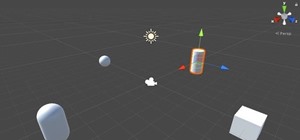Once mixed reality technology is more widely available and realistically priced for consumers, using the tech to create the illusion of a larger space, will likely be a favorite use for mixed reality in places where real-estate is expensive, people tend to live in smaller homes and work in tighter offices.
When the walls feel like they're closing in, mixed reality could be a perfect solution—virtual expansion.

A new HoloLens proof of concept video from YouTuber Exanaview shows the first example of this use case in action: An app that allows the user to select large areas of their spatial maps exterior and subtract it creating the illusion that the space is much larger than it is.
By all appearances, Exanaview is using Unity to lay down points to select an area and then begin cutting sections out of the wall in a very subtractive nature. Assuming this is true, this is more or less the opposite way Unity is designed to be used—an impressive feat in itself.
In video game design (an easily comparison to what's shown in the video above) the two main competing game engines these days are Unreal and of course, the engine HoloDevers are all familiar with Unity. Unity is your standard additive game engine. What that means is that you add objects to the engine to build a play space, often creating them in an external software package like Maya. While Unreal can work in this mode, it was designed from the ground up to be a subtractive engine.
To better explain that what subtractive modeling is, imagine the area you are working with is a large block of clay. To make a game level that was say—an air hanger—you would have to cut an air hanger shaped chunk out of that block of clay. At that point, you could fill it with platforms and vehicles. This is a great way to build interior levels, though not ideal for designing or creating exterior, open spaces.
Not only is this a cool demonstration of virtual expansion—what I think of as the "magic window" effect, the creation of windows, or walls, peering into other worlds using mixed reality. It is also a great example of how you can use real-time spatial design and modeling on the HoloLens, similar to Unity's EditorVR for virtual reality.
Would you use this technology to work at a virtual beach? Do you look forward to spatial design tools in the HoloLens? Let us know in the comments below.
Just updated your iPhone? You'll find new features for Podcasts, News, Books, and TV, as well as important security improvements and fresh wallpapers. Find out what's new and changed on your iPhone with the iOS 17.5 update.























Be the First to Comment
Share Your Thoughts